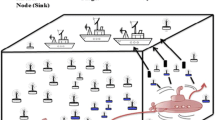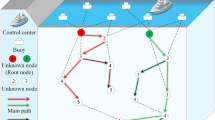Abstract
Underwater positioning and tracking scheme for non-cooperative objects is of great essence to explore unknown fields. Due to the high response time and non-line-of-sight(NLOS) propagation in the underwater acoustic sensor networks (UASNs), the existed range-based 3D target tracking algorithms are generally inaccurate on detecting underwater non-cooperative objects. In order to solve the problems above, the corresponding solutions are presented respectively in this paper. Although it is hard to change the inherent property of the underwater acoustic propagation, reducing the communication time is another way to solve the problem indirectly. Since the ranging phase and synchronize phase occupy most of the communication time, the presented novel ranging scheme for non-cooperative objects reduces the redundant time consumption, and further eliminates the necessity of synchronization process in advanced. For NLOS propagation, a distributed residual weighting discrimination (DRWD) algorithm based on grouping strategy is proposed for non-cooperative objects. The position estimations of the groups containing the NLOS link error are always distributed in isolation, and the estimations without the NLOS link errors are always concentrated in a small range. According to this feature, a low computational complexity approach namely two-step least square (LS) is proposed to determine the best location by analyzing the distribution of estimated coordinates. Meanwhile, a parameterized selection strategy is proposed first time to evaluate the construction of reference nodes in 3D target tracking. We provide a mathematical proof for our strategy, which avoids the ambiguity occurrence caused by the distribution of reference nodes. The new scheme provided for underwater acoustic tracking (UWAT) greatly improves the positioning accuracy in mixed LOS/NLOS environment. At the end of the paper, simulations are illustrated to evaluate and validate the algorithmic superiority and effectiveness.













Similar content being viewed by others
References
Heidemann J, Ye W, Wills J, Syed A, Li Y (2006) Research challenges and applications for underwater sensor networking. In: Wireless Communications and Networking Conference, 2006. WCNC 2006. IEEE, vol. 1, pp. 228–235 IEEE
Chandrasekhar V, Seah WK, Choo YS, Ee HV (2006) Localization in underwater sensor networks:survey and challenges. In: IEEE Signal Processing and Communications Applications Conference, pp 33–40
Liu Z, Wang S, Liu Y, Wang Y (2018) Secrecy transmission for femtocell networks against external eavesdropper. IEEE Trans Wirel Commun 99:1–1. https://doi.org/10.1109/TWC.2018.2836431
Erol-Kantarci M, Mouftah HT, Oktug S (2011) A survey of architectures and localization techniques for underwater acoustic sensor networks. IEEE Commun Surv Tutorials 13(3):487–502
Liu Z, Wang J, Xia Y, Fan R, Jiang H, Yang H (2016) Power allocation robust to time-varying wireless channels in femtocell networks. IEEE Trans Veh Technol 65(4):2806–2815
Rawat P, Singh KD, Chaouchi H, Bonnin JM (2014) Wireless sensor networks: a survey on recent developments and potential synergies. J Supercomput 68(1):1–48
Chitre M, Shahabudeen S, Stojanovic M (2008) Underwater acoustic communications and networking: Recent advances and future challenges. Mar Technol Soc J 42(1):103–116
Berger CR, Zhou S, Willett P, Liu L (2008) Stratification effect compensation for improved underwater acoustic ranging. IEEE Trans Signal Process 56(8):3779–3783
Ramezani H, Rad HJ, Leus G (2013) Target localization and tracking for an isogradient sound speed profile. IEEE Trans Signal Process 61(6):1434–1446
Patwari N, Ash JN, Kyperountas S, Hero AO, Moses RL, Correal NS (2005) Locating the nodes: cooperative localization in wireless sensor networks. IEEE Signal Process Mag 22(4):54–69
Wang B, Zhou S, Liu W, Mo Y (2015) Indoor localization based on curve fitting and location search using received signal strength. IEEE Trans Ind Electron 62(1):572–582
Wang G, So AM-C, Li Y (2016) Robust convex approximation methods for tdoa-based localization under nlos conditions. IEEE Trans Signal Process 64(13):3281–3296
Liu Z, Zheng Q, Xue L, Guan X (2012) A distributed energy-efficient clustering algorithm with improved coverage in wireless sensor networks. Futur Gener Comput Syst 28(5):780–790
Vaghefi RM, Gholami MR, Buehrer RM, Strom EG (2013) Cooperative received signal strength-based sensor localization with unknown transmit powers. IEEE Trans Signal Process 61(6):1389–1403
Zhou Z, Peng Z, Cui J-H, Shi Z, Bagtzoglou A (2011) Scalable localization with mobility prediction for underwater sensor networks. IEEE Trans Mob Comput 10(3):335–348
Braca P, Willett P, LePage KD, Marano S, Matta V (2014) Bayesian tracking in underwater wireless sensor networks with port-starboard ambiguity. IEEE Trans Signal Process 62(7):1864–1878
Stojanovic M (2007) On the relationship between capacity and distance in an underwater acoustic communication channel. ACM SIGMOBILE Mob Comput Commun Rev 11(4):34–43
Domingo MC (2008) Overview of channel models for underwater wireless communication networks. Phys Commun 1(3):163–182
Cho H-H, Chen C-Y, Shih TK, Chao H-C (2014) Survey on underwater delay/disruption tolerant wireless sensor network routing. IET Wireless Sens Syst 4(3):112–121
Carroll P, Zhou S, Mahmood K, Zhou H, Xu X, Cui J-H (2012) On-demand asynchronous localization for underwater sensor networks. In: Oceans, 2012, pp 1–4 IEEE
Cheng X, Shu H, Liang Q, Du DH-C (2008) Silent positioning in underwater acoustic sensor networks. IEEE Trans Veh Technol 57(3):1756–1766
Diamant R, Tan H-P, Lampe L (2010) Nlos identification using a hybrid toa-signal strength algorithm for underwater acoustic localization. In: Oceans, 2010, pp. 1–7 IEEE
Yu K, Guo YJ (2009) Statistical nlos identification based on aoa, toa, and signal strength. IEEE Trans Veh Technol 58(1):274–286
Diamant R, Tan H-P, Lampe L (2014) Los and nlos classification for underwater acoustic localization. IEEE Trans Mob Comput 13(2):311–323
Chen P-C (1999) A non-line-of-sight error mitigation algorithm in location estimation. In: Wireless Communications and Networking Conference, 1999. WCNC. 1999 IEEE, vol. 1, pp. 316–320 IEEE
Hammes U, Zoubir AM (2010) Robust mobile terminal tracking in nlos environments based on data association. IEEE Trans Signal Process 58:5872–5882
Yin F, Fritsche C, Gustafsson F, Zoubir AM (2013) Toa-based robust wireless geolocation and cramér-rao lower bound analysis in harsh los/nlos environments. IEEE Trans Signal Process 61(9):2243–2255
Huang Y, Liang W, Yu H-b, Xiao Y (2008) Target tracking based on a distributed particle filter in underwater sensor networks. Wirel Commun Mob Comput 8(8):1023–1033
Liu Z, Gao H, Wang W, Chang S, Chen J (2015) Color filtering localization for three-dimensional underwater acoustic sensor networks. Sensors 15(3):6009–6032
Tian C, Liu W, Jin J, Wang Y, Mo Y (2007) Localization and synchronization for 3d underwater acoustic sensor networks. Ubiquitous Intelligence Comput, pp 622–631
Zhou Z, Cui J.-H., Zhou S (2007) Localization for large-scale underwater sensor networks, Networking 2007. Ad Hoc and Sensor Networks, Wireless Networks, Next Generation Internet, pp 108–119
Isbitiren G, Akan OB (2011) Three-dimensional underwater target tracking with acoustic sensor networks. IEEE Trans Veh Technol 60(8):3897–3906
Acknowledgements
This work is partly supported by National Natural Science Foundation of China under grant 61473247, 61571387 and the Natural Science Foundation of Hebei Province under grant F2017203140 and F2017203084.
Author information
Authors and Affiliations
Corresponding author
Additional information
Publisher’s Note
Springer Nature remains neutral with regard to jurisdictional claims in published maps and institutional affiliations.
This article is part of the Topical Collection: Special Issue on Big Data and Smart Computing in Network Systems
Guest Editors: Jiming Chen, Kaoru Ota, Lu Wang, and Jianping He
Rights and permissions
About this article
Cite this article
Yuan, Y., Li, Y., Liu, Z. et al. A three dimensional tracking scheme for underwater non-cooperative objects in mixed LOS and NLOS environment. Peer-to-Peer Netw. Appl. 12, 1369–1384 (2019). https://doi.org/10.1007/s12083-018-0678-5
Received:
Accepted:
Published:
Issue Date:
DOI: https://doi.org/10.1007/s12083-018-0678-5




